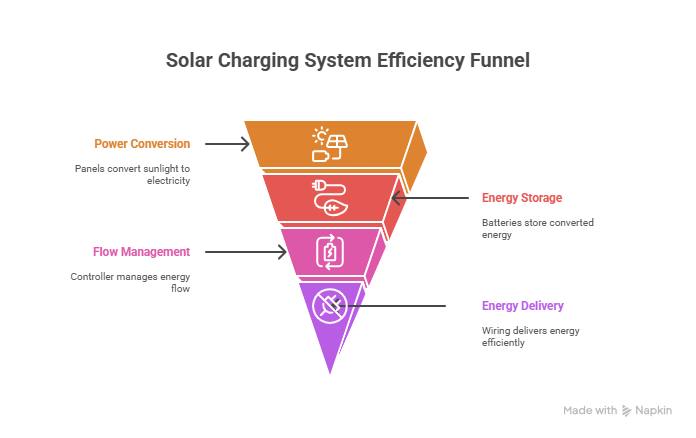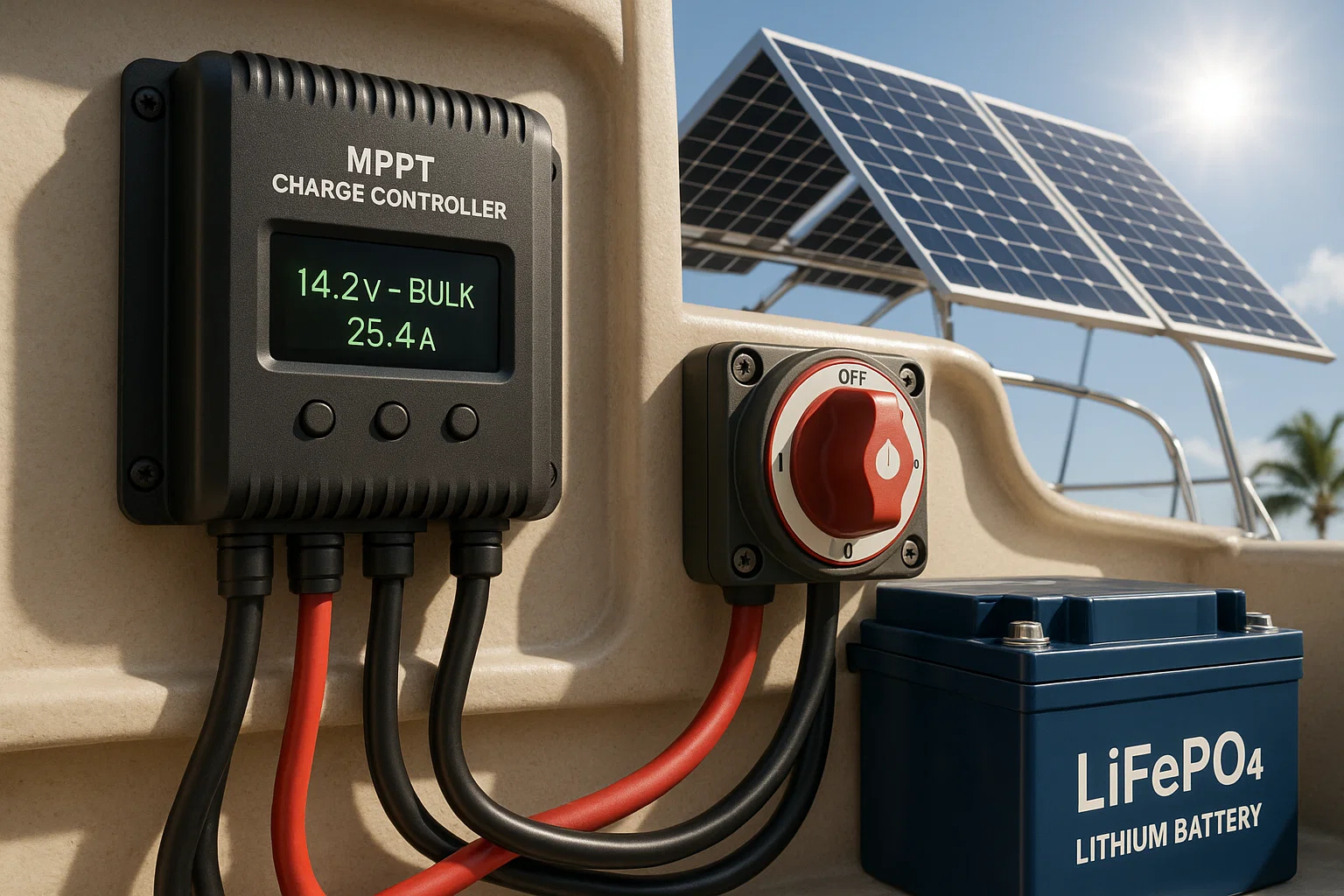The Dead Fridge and the Warm Beer Problem
A few months ago, a guy named Mike with a beautiful Hunter 41 calls me down to Coconut Grove. He’s frustrated. He’d spent a ton of money on a big solar array, but by evening, his batteries were already gasping for air. “Alex,” he said, “I have four huge panels up there, and my fridge is barely cold by sunset. What gives?”
His problem wasn’t a lack of panels. His problem was his system. He was trying to use brand-new solar panels for charging boat batteries that were old-school lead-acid, hooked up with a cheap controller and skinny wires. He was collecting sunshine like a champ but pouring it into a leaky bucket with a tiny straw.
This is the story I see all the time. People get fixated on the wattage of the panels and forget about the rest of the chain. Getting solar panels for charging boat batteries effectively isn’t about one magic component. It’s about building a smart, balanced system where every part works together.
So, let’s talk about how to do it right. I’ll walk you through the four pillars of a fast, efficient solar charging system, so you don’t end up like Mike with warm beer and a dead fridge.
Table of Contents
It’s a System, Not Just a Panel
Think of it like this: your solar charging system is a bucket brigade. The panels are the guys scooping water from the well. The wiring is the buckets. The controller is the foreman telling them how fast to pour. And the batteries are the big tank you’re trying to fill. If any one of those parts is slow or leaky, the whole operation grinds to a halt.
- High-Efficiency Panels: These are your power source. You need good ones to scoop up as much sun as possible.
- Modern Batteries: This is where the power is stored. The type of battery determines how fast it can accept that power.
- A Smart Controller: This is the brain. It manages the flow to keep things fast but safe.
- Good Wiring: This is the highway. Bad wiring creates traffic jams and wastes energy.
Let’s break down each piece.
Pillar 1: The Panels – Your Sunshine Catchers
We’ve talked about panels before, but when the goal is specifically charging boat batteries, efficiency is paramount. You need panels that can deliver a strong, consistent current.
Given the limited space on a boat, high-efficiency monocrystalline panels are the only way to go. They produce more power per square foot, which is exactly what you need. A well-placed set of solar panels for charging boat batteries should be able to deliver their rated power even when the Florida sun isn’t directly overhead.
For portable needs, something like a 50W folding panel can be great. But for your main system, rigid panels mounted on an arch or hardtop are always going to be the most durable and reliable choice for a serious solar charging setup.
Pillar 2: The Batteries – The Heart of the System
This is where Mike went wrong, and it’s the biggest game-changer for fast charging. His lead-acid batteries just couldn’t absorb power quickly.
Lithium (LiFePO₄) is the Gold Standard.
I can’t say this enough: if you’re serious about using solar panels for charging boat batteries, you need to switch to lithium. They are a completely different animal.
- They Absorb Power Like a Sponge: A lithium battery can take almost the full output of your solar panels right up until it’s nearly full. A lead-acid battery, on the other hand, starts to slow down its charge rate dramatically once it hits about 80%. This is the single biggest factor in charging speed.
- They’re More Efficient: You get more of the power you put in back out. With lead-acid, you can lose 15-20% of the energy just in the charging and discharging process.
Upgrading to a quality lithium battery bank is the fastest way to improve your solar charging speed. It’s like switching from a tiny straw to a firehose. Proper solar panels for charging boat batteries deserve a battery bank that can keep up.
Pillar 3: The Controller – The Brains of the Outfit
Your charge controller is the unsung hero. It manages the power from the panels and feeds it to the batteries in a way that is both fast and healthy for them.
MPPT is a Must.
Forget PWM controllers unless you have a tiny system on a dinghy. An MPPT (Maximum Power Point Tracking) controller is essential for an efficient setup. It constantly adjusts to pull the absolute maximum power from your panels, giving you up to 30% more energy over the course of a day.
When you’re using solar panels for charging boat batteries, especially expensive lithium ones, the controller is also your safety net. It uses multi-stage charging to push a lot of power in the “bulk” phase and then tapers off to protect the battery as it fills up. A good controller with a specific lithium charging profile is non-negotiable.
Pillar 4: The Wiring – The Unsung Hero
I make a lot of money fixing problems caused by bad wiring. It’s the most overlooked part of any installation of solar panels for charging boat batteries.
Using wire that’s too thin is like trying to drink a milkshake through a coffee stirrer. It creates resistance, which generates heat and wastes precious energy. All that power your panels worked so hard to create just bleeds away before it even gets to the batteries.
Use proper, marine-grade tinned-copper wire, size it correctly for the amperage and the length of the run, and use high-quality, heat-shrunk connectors on every single terminal. This isn’t just about efficiency; it’s about safety.

FAQ: Quick Answers from the Workshop
How do I size my system?
First, do a “load audit.” Figure out how much power you use every day. Your solar array should be large enough to replace that daily usage and have enough extra juice to top off the batteries. A good rule of thumb for fast charging is to have your panel wattage be at least 25-30% of your lithium battery bank’s amp-hour capacity (e.g., at least 250W of solar for a 100Ah battery).
What if my charging is still slow?
Check for shade first. Then, check every connection for corrosion. If those are good, your batteries might be getting old, or your controller settings could be wrong. Using solar panels for charging boat batteries effectively is often a process of elimination.
Is professional installation worth it?
For a simple, one-panel setup, maybe not. But for a full system with multiple panels and a lithium bank? Absolutely. A certified marine electrician will ensure it’s safe, efficient, and won’t void your warranties.
The Bottom Line: My Final Advice
Look, getting solar panels for charging boat batteries right isn’t complicated, but it requires you to think about the whole system, not just one part. Before you spend any money, remember this:
- It’s a Four-Part System: Great panels are useless without the right batteries, controller, and wiring. Your system is only as strong as its weakest link.
- Lithium is a Game-Changer: If fast charging is your goal, upgrading to LiFePO₄ batteries is the single most effective thing you can do.
- Invest in an MPPT Controller: Don’t cheap out on the brain. A good MPPT controller will pay for itself in harvested power.
- Wiring Matters More Than You Think: Use the right size marine-grade wire and make your connections bombproof. This is where most DIY systems fail.
- Do Your Homework First: Conduct a thorough load audit to know exactly how much power you need. Sizing your system correctly from the start will save you a world of frustration.
Follow these principles, and you’ll have a robust system that keeps your batteries topped off, your fridge cold, and your generator off. And that’s a beautiful thing.
Author Bio
I’m Alex, a 15-year marine technician in South Florida, ABYC-certified. I specialize in marine electrical systems, from diagnosing power drains to designing and installing complete solar charging solutions for liveaboards at marinas like Dinner Key and Bahia Mar.


Leave a Reply